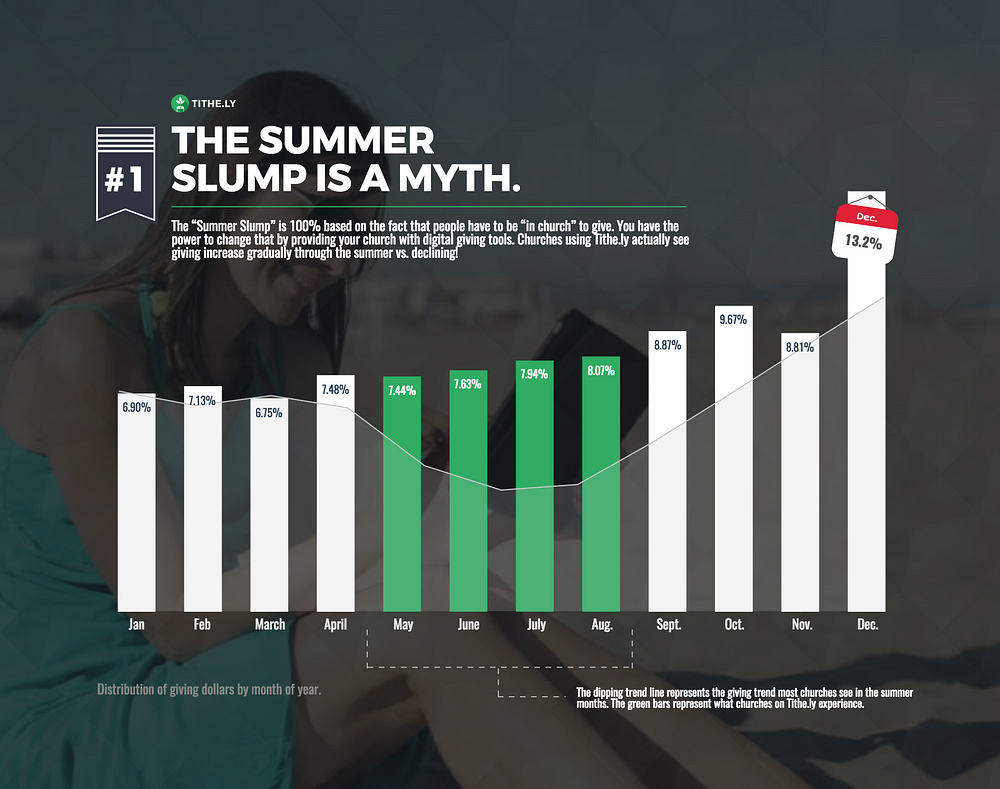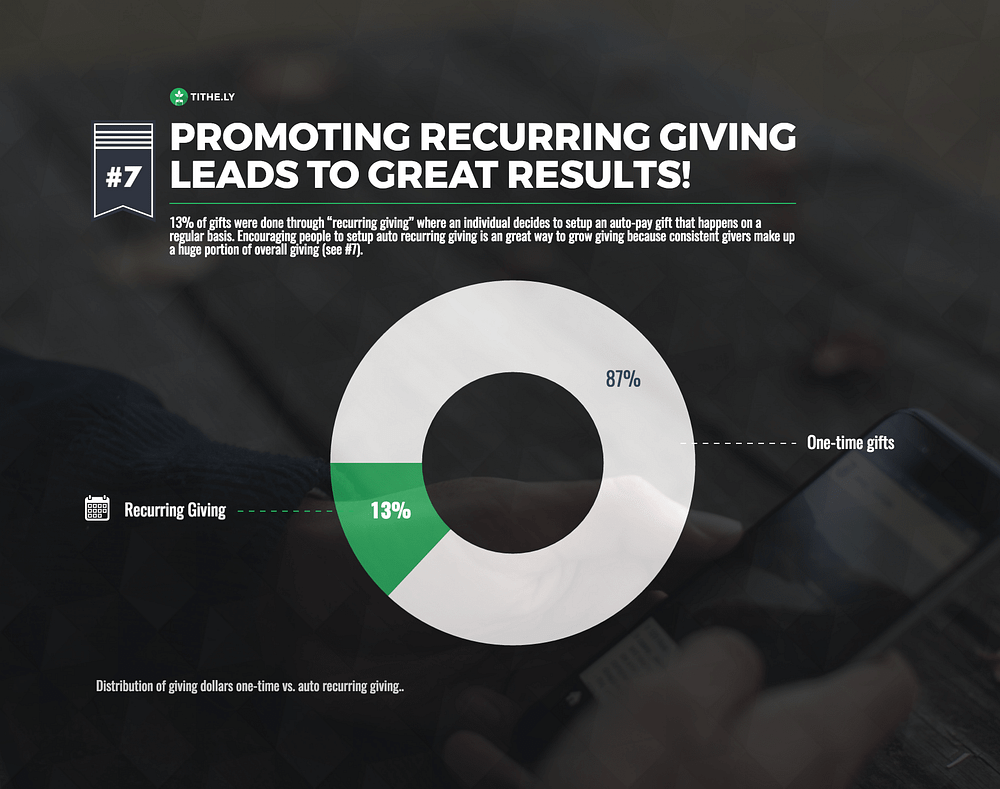
Our friends and ministry partner, Tithe.ly, has put together the based on churches using Tithe.ly for mobile, text, and online digital giving. Below is a repost of a blog entry originally posted on their site on April 2, 2017.
In just about any field, there’s always the “standard” advice that seems to get repeated all over the web without any real proof.
And then there’s the truth.
Researched and proven findings that, although sometimes unconventional, can hold the keys to better results.
It’s with that in mind that we share real church giving research based on thousands of churches and donors giving hundreds of thousands of gifts.
Let’s jump in.
1) Digital Giving by Month
It’s common for churches to see what’s been thoughtfully coined “the summer slump” where giving declines in the May-Aug window. Many churches see a twenty percent or more hit in giving during those months due to members being on vacation, going to BBQs, traveling with family, etc.
If you look a the chart below you’ll notice something odd?—?it doesn’t look like the normal giving distribution that churches all over see. There is NO SUMMER SLUMP!
The fact is, giving people great mobile first options enables anytime, anywhere giving. Vacation, work travel, sick, rained or snowed in, regardless of the reason, when people can give by mobile app, web or text, they’ll do it even if they’re not in the building on Sunday morning.
Also, beyond the fact that churches using Tithe.ly don’t see a slump in the summer, it’s also import to pay attention to the way giving tends up and to the right as the year goes on with over 31% of all church giving happening in the last three months of the year.
Key takeaway: The “Summer Slump” is 100% based on the fact that people have to be “in church” to give. You have the power to change that by providing your church with digital giving tools.

2) Digital Giving by Day of Month
You might guess that giving to churches mostly happens based on when people get paid, but when you look at the data you might be surprised!
Giving spikes on the first and fifteenth, but take a look at the second, fifth, twelfth, nineteenth, and twenty-sixth. Fairly sizable spikes in giving for an unknown reason.
Key takeaway: Be sure financial giving is a common part of your worship and language so that you’re hitting peoples hearts at all times. You never know when someone will be ready to give.

3) Digital Giving by Day of Week
While Sunday accounts for 33% of digital giving, it’s crazy to see that when you give people the ability to give any time, anywhere, that that 67% of giving happens Monday through Saturday!
If you think about it, this makes total sense! Most people tend to manage their money and bills on their own time while also tending to align their “spend” (eg. paying bills, grocery shopping, etc) based on when they get paid which happens during a week day in most cases.
Key takeaway: Give people easy to use mobile first tools and options they so that they can give on their own terms.

4) Digital Giving by Hour of Day
40% of gifts come in between the hours of 9am and 2pm, which means that 60% of gifts come in early in the morning or late at night! Over 28% is given between 10pm and 7am?—?the “late hours” of the night.
Similar to giving by day-of-week, giving by hour-of-day tells us that people like to give when it’s right for them.
Perhaps donors are watching sermons late at night or reading a bible study and feel a call to give. Or they may just be working on their finances after a long day at work and with family.
Key takeaway: When you enable options for donors to give on their own terms, you open up more giving opportunities.

5) Digital Giving by Source
Mobile leads the charge when it comes to the way people prefer to give. 57% of giving across the Tithe.ly platform happened through the native iOS and Android app.
The ability to store your card or bank account, track your personal giving, setup and manage recurring giving and other little benefits make app-based mobile giving the easiest way to give, hands down. In fact, when setup, it’s so easy that you can give in just 2-clicks using our QuickGive™ feature.
Of course, if you take mobile, text and web together, it’s clear to see that people, when given the opportunity, love digital giving! I mean, who carries checks or cash anymore? 🙂
Key takeaway: Give people digital options that include app, text, and web. Just text, or just app, or just web won’t cut it.

6) Digital Giving by Gift Size
Some may think digital giving is mostly for small gifts and that those who give large amounts still choose to use checks as their preferred means of delivering the funds, but the data shows that isn’t the case.
Over 80% of gifts processed on Tithe.ly were over $100, with 33% above $500, and 18% of the gifts processed on Tithe.ly were over $1000!
Key takeaway: People are no longer afraid to process transactions, big or small, through digital options.

7) Recurring vs. One-time Digital Giving
13% gifts given were done through “recurring giving” where an individual decides to setup an auto-pay gift that happens weekly, twice a month, or monthly, while 87% of digital gifts processed were one-time.
An interesting contrast is that we see many churches using Tithe.ly with over 50% of their giving coming in through auto recurring gifts. The key difference is that these churches educate members on the option to setup auto recurring giving and show the impact of that type of giving on the work of the church in the community.
Key takeaway: Educating your people on the option to setup recurring giving is often all it takes to go from average to great! You can easily get over 13% of your giving to be auto-recurring.

8) Digital Giving by Occasional vs. Consistent Givers
It’s likely something you already know, but the data proves it out. Consistent givers are also the most generous givers.
Looking at the chart below you’ll see that consistent givers?—?those that give at least one time a month?—?make up only 15% of the total population, but they account for 51% of the giving total!
Contrast that with 85% of givers being “occasional givers” who make up under 50% of the total giving.
Key takeaway: Education on giving and generosity, financial management, coupled with consistent calls to give, will help increase the number of “consistent givers” at your church.

9) Digital Giving by Method
In a mostly cashless society, we are very accustom to using using credit or debit cards for everything and when given the option, that holds true with our giving habits as well.
Only 7% of donors give by entering their bank account details. The vast majority of givers prefer using a debit or credit card. It could be due to the added layer of security, it could be because they’ve memorized their card info and don’t know their bank account/routing number, or it could be because they’re financially responsible people who want the card points/rewards.
Key takeaway: Given the choice, most people choose to use their credit/debit card. If you don’t offer this option you’re likely missing out on some people giving consistently.

10) Digital Giving by Card Type
This one might be of lesser interest, but it’s good data to understand from the perspective of having options. Clearly most people will give using a VISA or MasterCard credit or debit card, but offering AMEX and Discover is important for those individuals.
It’s also good to note that AMEX fees are generally higher, but it’s a very small porting of the overall giving pie.
Key takeaway: Along with digital giving options (text, web, app), be sure your service allows for the four major card brands as people use all of them.

It is clear that on the web, in app, and via text is essential to your church fundraising strategy! People are starting to expect these options as they get more and more accustom to “paying” for things with their phones?—?think Uber, Starbucks, Amazon, and the like.
It’s a fact, we’re becoming a mobile-first society and mobile giving is here to stay!
It is our hope that this data will help you as you prepare your giving strategy and messaging for your church. Data like this helps us avoid false assumptions and guess work, and focus on reality.



